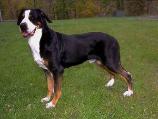
This is a placeholder text
Group text
by alexnds05 on 29 June 2023 - 09:06
The goal of any breeder is to improve a breed. There needs to be a consideration of prepotency in dogs and how attributes of past ancestors can be made more noticeable in the puppies. Since nobody can meet any dog, and some dogs are in either foreign countries or no longer alive, nobody can tell for sure what influence they have or don't have since you can't see the influence o of a particular ancestor without personally knowing this ancestor as frame of reference.
So we therefore have to go back to basics. What does the pedigree provide us: the Wright and Hardiman's coefficients. That is the very key to solving this problem. I will not re-explain the differences between the equations, as this can be found in this excellent article:
https://bloodlines.net/highflyer/coefficient.htm
Suffice it to say, Hardiman's 2000 equation is more accurate than Wright's 1922 equation. By lining up a common ancestor on maternal and paternal lines, we increase the homogeneity of that ancestor's genes. In the pedigree you mentioned, some ancestors are only 5-5, which is too far back in time to have sufficient influence. Here's some math to consider:
3-3, Coefficient of relationship is 25% and COI=6.25% which is .25 x .25=.0625.
In other words, a grandmother or common grandfather is 25% of common genes to all the grand-kids, but only a quarter of that number is homogeneous genes.
4-4 coefficient of relationship is 12.5% but COI is only .25 x .125=.03125 or 3.125%=COI
5-5 coefficient of relationship is 6.25% but COI is only .25 x .0625=0.015625, or 1.56%=COI
so the famous ancestors you mentioned have negligible effect at this point in your breeding considerations. However, they would have much more of an effect if you stacked it. For example
if you bred a 4-4 dog to a 3-4 dog with same ancestor in common. The offspring would be:
5-5, 4-5, or .5^5+.5^5+.5^4+.5^5.
So for example, if a common ancestor is 4-4, 4-4, it's same as if he is 3-3 mathematically speaking. In other words, you will not get a result in one breeding. Instead, you need to look for breeding candidates that share common ancestors to your dogs and stack the number of 4's and 5's in the past to a common ancestor. Then that ancestor actually matters, because otherwise it doesn't. That's the advise I would give you.
So we therefore have to go back to basics. What does the pedigree provide us: the Wright and Hardiman's coefficients. That is the very key to solving this problem. I will not re-explain the differences between the equations, as this can be found in this excellent article:
https://bloodlines.net/highflyer/coefficient.htm
Suffice it to say, Hardiman's 2000 equation is more accurate than Wright's 1922 equation. By lining up a common ancestor on maternal and paternal lines, we increase the homogeneity of that ancestor's genes. In the pedigree you mentioned, some ancestors are only 5-5, which is too far back in time to have sufficient influence. Here's some math to consider:
3-3, Coefficient of relationship is 25% and COI=6.25% which is .25 x .25=.0625.
In other words, a grandmother or common grandfather is 25% of common genes to all the grand-kids, but only a quarter of that number is homogeneous genes.
4-4 coefficient of relationship is 12.5% but COI is only .25 x .125=.03125 or 3.125%=COI
5-5 coefficient of relationship is 6.25% but COI is only .25 x .0625=0.015625, or 1.56%=COI
so the famous ancestors you mentioned have negligible effect at this point in your breeding considerations. However, they would have much more of an effect if you stacked it. For example
if you bred a 4-4 dog to a 3-4 dog with same ancestor in common. The offspring would be:
5-5, 4-5, or .5^5+.5^5+.5^4+.5^5.
So for example, if a common ancestor is 4-4, 4-4, it's same as if he is 3-3 mathematically speaking. In other words, you will not get a result in one breeding. Instead, you need to look for breeding candidates that share common ancestors to your dogs and stack the number of 4's and 5's in the past to a common ancestor. Then that ancestor actually matters, because otherwise it doesn't. That's the advise I would give you.
Contact information Disclaimer Privacy Statement Copyright Information Terms of Service Cookie policy ↑ Back to top




